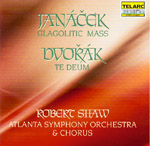Robert Shaw’s amazing choral prowess shows in the sumptuous sound of this Glagolitic Mass. As in many of his Atlanta performances, Shaw is more attuned to the vertical dimensions of the music at hand than the horizontal–a liability in a work like Janácek’s Mass, which requires extraordinary rhythmic projection and an almost fearless forward momentum to realize the music’s pagan majesty. The above qualities are abundant in Kubelik’s classic account with the Bavarian Radio Symphony, while Charles Mackerras contributes a wonderfully raw reading of the original version with his Danish National Radio forces. So, despite fervent and committed singing from the soloists, this recording doesn’t really make strong claims on your attention.
That is, until you hear Dvorák’s astonishing setting of the Te Deum. This magnificent work, commissioned by Harriet Thurber, was premiered by Dvorák at his first American concert at Carnegie Hall in 1892. It begins with a timpani volley (strangely similar to Falla’s Three Cornered Hat) that sets the dramatic, euphoric, and celebratory tone (and points the way, it seems, for Janácek’s own work). The piece sounds a lot like Dvorák’s late tone poems, especially The Golden Spinning Wheel, which is cut from the same stylistic cloth. The vocal writing is splendid, especially the finale’s soprano solo, wonderfully sung by Christine Brewer. Shaw seems more involved on this occasion, and the Atlanta Symphony follows suit with an energetic performance. Telarc captures it all in big, impactful sound. Worth it for one of the greatest 20-minute pieces of music ever.
































